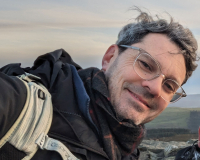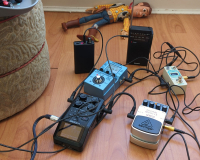Posted on Thu 25 Apr 2024
Final Thoughts on a Domestic Vocal System
There is not even a thought, or an invention, which is not common property, born of the past and the present. Thousands of inventors, known and unknown, who have died in poverty, have co-operated in the invention of each of these machines which embody the genius of man. Peter Kropotkin 'The…

Posted by

Dave Evans
Dave currently works with sound and livestreaming and is exploring how objects and spaces can be given voice. His work reframes the livestream, usually associated with efficiency or entertainment, as an expressive opportunity in an attempt to tackle the complex problem of hierarchies of social and…Project

Investigating a Domestic Vocal System
This project asks if domestic space can be considered as a vocal system, and if so, what sort of sounds would it make?There is not even a thought, or an invention, which is not common property, born of the past and the present. Thousands of inventors, known and unknown, who have died in poverty, have co-operated in the invention of each of these machines which embody the genius of man.
Peter Kropotkin 'The Conquest of Bread' 1892.
Now I am at the end of the residency in the PMS and would like to add one final post about how I have been thinking about the project and what the work itself reflects. In the previous posts I talked about where the idea to try to create a domestic vocal system came from, and how I went about it. I was happy to end up with a speculative vocal system that is made up of sounds from some subsystems, tied to the functioning of the space, which are then articulated to the world through another subsystem. The final form of this isn’t fixed, but you can listen in here.
Given that I am working with the home, or the house, I have been reading Gaston Bachelard’s 'Poetics of Space'. In fact, I’m still reading it, but I enjoyed the first chapter a lot. Bachelard talks about imagining the house as a ‘vertical being’ in which the roof, which it’s clear supportive framework, performs a rational function of keeping us sheltered, while the cellar has walls that ‘have the entire earth behind them’ that reflect an irrational subterranean ‘buried madness.’ This is all a bit too neat for me, and besides, I don’t live in a house with a cellar, and I try to avoid going into the loft at all costs. But,what is interesting is how Bachelard describes something he calls an ‘ultra cellar’ in 'The Antique Dealer,' a literary work by Henri Bosco. I don’t have time or space to go into too much detail, but the narrative of the story depicts a set of underground tunnels beneath a house, one of which opens on to an expanse of water. Bosco describes how, filtered through the densely compacted rock into which the cellar had been dug, the water becomes ‘a substance charged with phosphorescences that only appeared on the surface in occasional flashes. These electric tints, which were signs of the dark powers lying on the bottom, manifested the latent life and formidable power of this still dormant element.’ I like how Bachelard describes the poetic image of water in this ultra cellar as combining reality and dream. He suggests that the ‘house has become a natural being whose fate is bound to that of mountains and of the waters that plough the land.’ I love this image, the flashes of water in this imaginary underground water connecting the reader to the world beyond the house. Hopefully this provides a hint as to why I am making the reference – when I attach a mic to the washing machine, or listen to the gurgling of our fridge, or the dripping of our tap, and investigating these noises as 'voice', does it begin to speak of the complex network of elements that we use to sustain us?
This also links into something I was lucky enough to chat with James Bridle, writer of ‘Ways of Being’, about during a Zoom call, organised as part of the residency at the PMS. I wish I had recorded it, but, to paraphrase from memory, James was talking about the chain of events and materials that contribute to the production of the things that surround us. Producing and running a fridge, for example, requires a lot of work, mining metals, the production of gases, the transport of materials, the generation of electricity etc. All of this happens, just so the appliance can sit quietly in the corner of our kitchen, keeping our food cool. This activity though, is not quiet, at all. Mining isn’t quiet, trucks moving materials aren’t quiet. So, can the sound that is produced when I attach a contact mic to the fridge be thought of as the amplification of this succession of embedded extraction, labour, movement, and so on? And to develop this further, if the basic model of the human vocal system, as I mentioned in my last post, is made up from connected subsystems, can this amplification be considered the product of a similar complex subsystem that can also produce a voice? In the same way that the ‘latent life’ that appears through the water in Bachelard’s poetic cellar connects the reader to the mountains, can the ‘voice’ produced by the fridge connect the listener to the complexities of its production?
It was great to talk to James, and what we discussed above nicely expands on the thoughts that I had been having around domestic labour, how people, spaces, and devices associated with care are generally designed to be quiet and unobtrusive. As a counterpoint to this, someone at also PMS pointed out that nobody wants to listen to a noisy fridge, and that quietness is good for us. This threw me a bit, as it is so obviously true. But on reflection, even as domestic laborers, while it is relatively quiet for us, with our hoovers and washing machines, it is noisy for someone else, somewhere else, engaged in the production and maintenance of these things. The quietness of my house is a privilege that requires noise elsewhere. As an artist desperately trying to reflect the complexities of the situation I find myself in, perhaps this ‘voice’ that comes from these devices can ‘sing’ a ‘song’ that gestures towards these hidden, or embedded materials, processes and people?
As you can see, the more I have worked on this domestic vocal system, the more I have become conscious of the flow of electricity, people, signals and so on, that move through our house. Water through pipes, electricity through devices, people up and down stairs and in and out of doors, packets of data flying across our wireless network. It’s all go, and much of it starts very far away. So lastly, I’d just like to reflect on the last stage of the this speculative vocal system, the live stream that combines some of this movement and send it onwards. I think I love the idea of making art out of the live stream/broadcast partly because it is so awkward as a material. Despite its cultural importance over the last 100 years, there isn’t much of it in art history, and more recently has been corporatized through Zoom, and spectacularised through Twitch. But, for me, even the name resonates, the stream. In my imagination a stream is like Bosco's pool of cellar water, it is groundwater that collects into a small flow water that carries other stuff along with it to eventually join something larger. Despite maybe a risk of mixed metaphors, there is a nice overlap with vocal systems, of things coming together and moving onward. Where the stream metaphor is useful in thinking about voice, I think, is in its horizontality. The human voice is a vertical structure moving upwards, from the lungs through the larynx and mouth. The voice I have become interested in is much more complicated and distributed, again, Bachelard’s vertical metaphor of the house with a roof and cellar is not quite up to it. I like the water in the cellar. Thanks to some recommendations I have been reading about Rhizovocality and Polyvocality, strategies for giving voice that actively elude fixity and singularity in favour of the creation of a shared meaning that acknowledges complexity and difference. It’s this that the stream metaphor encourages in voice. At home, the contact mic attached to the fridge revives the noise of its production, the mic attached to the radiator signifies the silent flow of water, and the sensor next our router turns the silent flow of data into clicks and crackles. These all then flow to the assemblage on our back-room shelf, combining through an audio interface and into a Raspberry Pi and onto the server, waiting for a connection to be made before flowing into a browser window somewhere else. What comes out there is anyone’s guess, it changes, it breaks, it’s too loud, too quiet, it’s occasionally lovely. But, I have decided that it is a voice, of the combined complexities of that moment turned to song.
As this is my last blog post for the residency I would like to say thanks to Vic, Martin, Tony, James and everyone else at PMS and Watershed for their support. It’s been great, my work has moved into exciting new territory and I’m looking forward to sharing with them where it goes next.